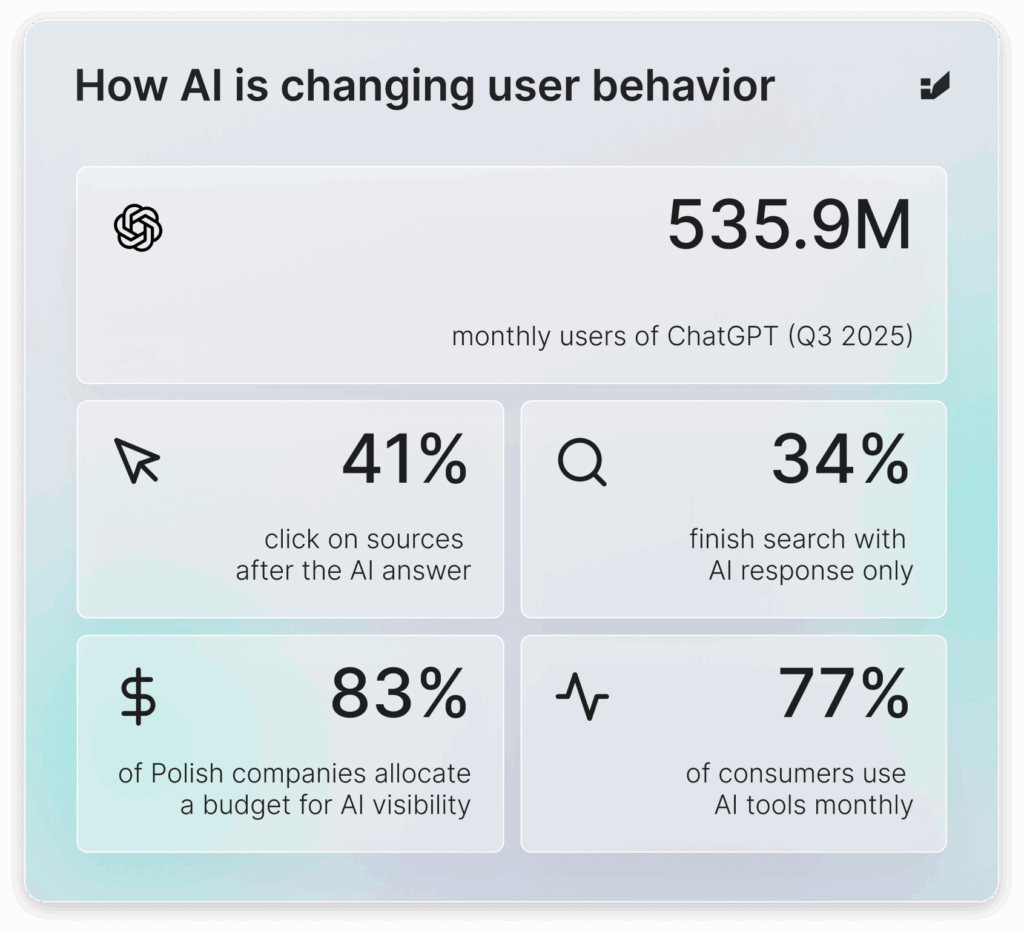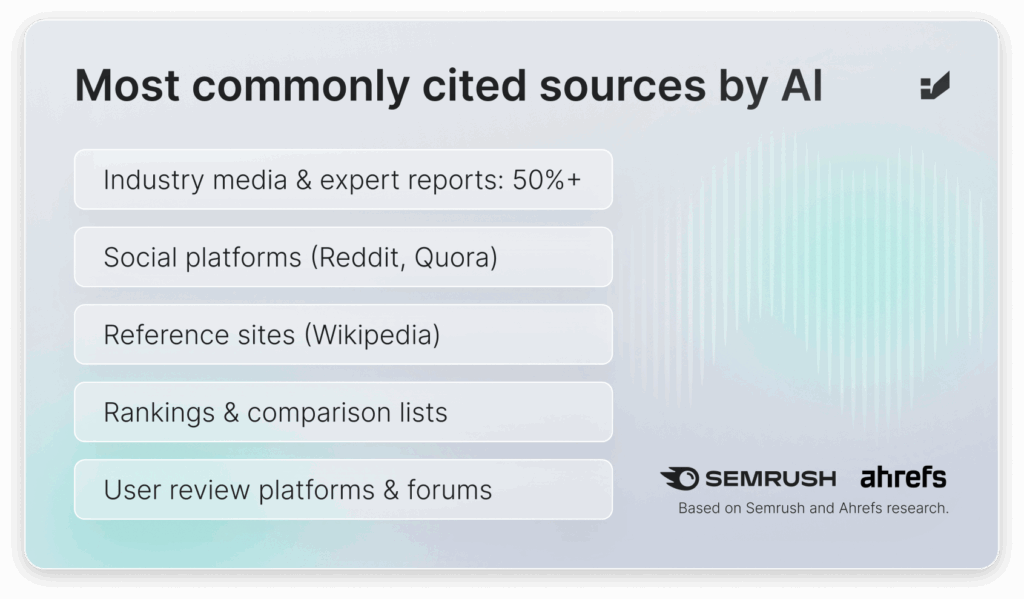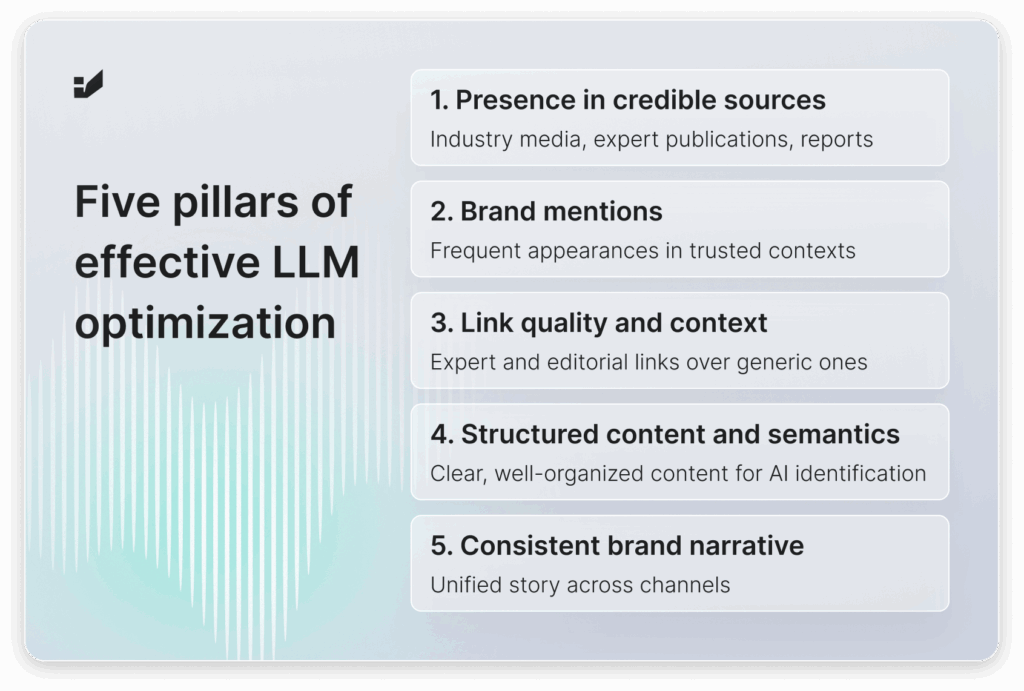AI search optimization: how to control what artificial intelligence says about your brand
Until recently, brands focused mainly on visibility in Google search results. Today, the key channel for reaching users is shifting toward generative models such as ChatGPT, Gemini, and Perplexity. These tools don’t display lists of links but provide a single, concise answer.

For brands, this marks a new reality: visibility in AI search is becoming as important – and often more so – than traditional SEO.
How AI is changing user behavior
AI is quickly becoming a crucial touchpoint between users and brands. More people now get product and company information directly from AI-generated responses, moving part of the interaction away from traditional search results.
- ChatGPT had over 535.9 million unique monthly users in Q3 2025 (Semrush, 2025).
- 41% of users click on a source after reading an AI-generated answer, while 34% finish their search with the AI response alone (Search Engine Land, 2025).
- 83% of Polish companies have already allocated or plan to allocate budgets for AI visibility (Insightland, 2025).
- 77% of consumers use AI tools at least once a month (Insightland, 2025).
- 50% of users trust AI as much as – or more than – traditional search engines (Insightland, 2025).
In short, the main brand touchpoint is moving from search results to AI-generated content.

What is AI search optimization?
AI Search Optimization (AISO) – also called Generative Engine Optimization (GEO) – focuses on improving how and where your brand appears in AI-generated answers.
Unlike traditional SEO, which aims for high rankings in SERPs, AISO is about:
- Whether your brand is mentioned in AI answers,
- How it’s presented,
- And whether it’s framed as a leader, recommendation, or background mention.
In AISO, the goal isn’t just to rank – it’s to be seen, mentioned, and positioned in the right context.

Why it matters
Generative models like ChatGPT or Gemini are now the first step for many users seeking information. They create summarized answers that often influence decisions directly. That means brands need to care not only about rankings but also about how they’re represented in AI outputs. AI search blends SEO, SERM, PR, and content strategy into one approach.
If you want to learn more about this concept, see Generative Engine Optimization: Everything You Need to Know for 2025.
Where AI gets information about brands
AI models don’t work like search engines. They combine data from various sources to generate answers.
1. Training datasets (pre-training)
Large datasets include websites, academic papers, media, blogs, and forums. Brands already present in trusted sources have a higher chance of being recognized by AI.
2. Live search results (browsing mode)
Models update their knowledge with recent data, usually from authoritative, regularly updated sources with a good reputation – like industry media and expert portals.
3. Trusted and authoritative sources
AI favors content from reliable domains that show expertise and consistency. Studies from Semrush and Ahrefs confirm that frequent mentions, high domain authority, and contextual relevance all boost visibility in AI answers.

Most commonly used source types
- Industry media and expert reports – over 50% of AI-cited sources come from high-authority domains (Semrush, 2025).
- Social and discussion platforms (UGC) – sites like Reddit or Quora often appear among the top references (Semrush, 2025).
- Reference sites – Wikipedia and similar encyclopedic sources remain key factual references (Semrush, 2025).
- Rankings, lists, and comparisons – “Top 10” articles are especially influential in shopping-related categories (Ahrefs, 2025).
- User review platforms – forums, marketplaces, and review sites help validate AI-generated recommendations (Semrush, 2025).
Why this matters
AI doesn’t invent opinions – it reflects what it finds online. A brand that appears in credible, consistent, and recurring contexts has a higher chance of being presented positively. Without that presence, the model may ignore or misrepresent the brand.
How AI chooses what to display in a response
Unlike Google, which ranks pages, AI models synthesize information to create a coherent narrative. Simply ranking high in search results doesn’t guarantee inclusion in AI-generated responses.
Key factors include:
- Frequency of brand mentions across credible sources
- Narrative context – how your brand is described (leader, neutral, or recommended)
- E-E-A-T signals – expertise, experience, authoritativeness, and trustworthiness
- Consistent messaging across multiple platforms
Summary
AI doesn’t select the “best” links – it chooses the most representative narrative based on mention frequency, source authority, context, and consistency.
5 pillars of effective LLM optimization
Visibility in generative model answers depends on several credibility signals:
- Presence in credible sources – industry media, expert publications, and reports carry more weight than raw rankings.
- Brand mentions – frequent appearances in trusted contexts matter more than backlinks.
- Link quality and context – expert and editorial links outperform generic ones.
- Structured content and semantics – clear, well-organized content helps AI identify key information.
- Consistent brand narrative – repeating a unified story across channels helps AI recognize and reinforce your positioning.

How to measure AI search optimization effectiveness
Unlike traditional SEO, AISO success isn’t measured by rankings but by how and where your brand appears in AI-generated answers.
Ask:
- Does your brand appear in AI-generated responses?
- How is it framed – as a leader, recommendation, or neutral mention?
- Who are your competitors in these contexts?
- Which sources does the AI cite most often?
- Is your narrative consistent across outputs?
Common AISO metrics include:
- AI citation frequency – how often your brand is mentioned by AI models
- Context positioning score – how your brand is presented in narratives
- Competitor share of voice – your brand’s share of mentions versus others
- Brand consistency index – how coherent your brand’s story is across models
Monitoring tools and methods:
- Manual testing – checking brand mentions in model responses
- Narrative analysis – reviewing tone and framing
- Analytical dashboards – tracking data trends over time
Tools like Semrush AI Toolkit and Ahrefs Brand Radar already support these analyses. For a more technical take, see Measuring data from generative chatbots.
Pro tip
Regularly tracking AI-generated responses helps spot both opportunities and risks – like outdated info or negative associations. That’s where Brand Search Presence by Insightland comes in, offering:
- Visibility audits across ChatGPT, Gemini, and Copilot
- Tone and framing analysis
- Competitor benchmarking
- Actionable recommendations for better AI control
Strategic directions for brands
AI visibility isn’t a matter of “if” – but “how well.” Generative models shape brand perception and purchasing decisions, so strategy must go beyond SEO.
- Turn SEO into GEO – focus on appearing in AI recommendations, not just SERPs.
- Build expert reputation – prioritize credible mentions and expert content.
- Monitor the AI narrative – stay aware of tone and context.
- Manage context – influence how your brand appears alongside competitors.
- Integrate PR, content, and SEO – create a consistent, trustworthy presence.

Conclusion
AI search is already transforming how people discover brands. Visibility in AI depends on quality sources, frequent mentions, and consistent narratives. Brands that invest in AISO now gain not only better search visibility but also stronger recognition in users’ minds.
“AI doesn’t just answer questions. It tells your brand’s story – make sure you’re the one writing it.”


